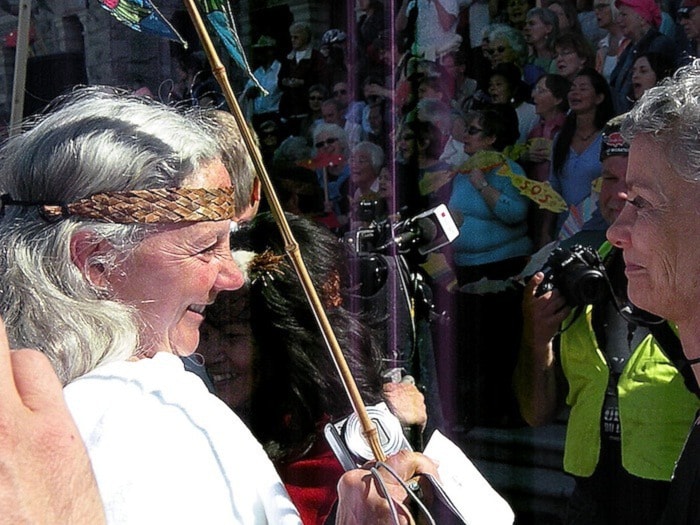Biologist and anti-aquaculture activist Alexandra Morton was scorned Wednesday and accused of ethical breaches in her crusade to tie ocean salmon farms to the collapse of the Fraser River's wild sockeye runs.
Morton, executive director of the Raincoast Research Society, defiantly stood her ground in the first of two days of grilling before the Cohen Inquiry.
She was pressed on how she can categorically say salmon farms cannot safely co-exist with wild runs when most other scientists testifying before the commission have said – with varying degrees of certainty – that it should be possible.
"I am completely independent," Morton replied, adding she doesn't work for a university, government or other vested interests.
"You are pure, are you? You're the only one that isn't corrupted by business, by government, by a university?" asked Aboriginal Aquaculture Association lawyer Steven Kelliher in cross-examination.
"Perhaps," she said.
The exchange came after lawyers for the provincial and federal governments and B.C.'s salmon farming industry sought to exclude from evidence a new report Morton wrote summarizing her findings for the inquiry.
"The document is full of hearsay and speculation," charged Alan Blair, representing the B.C. Salmon Farmers' Association at the inquiry.
He said Morton drew scientific conclusions "far beyond her expertise" and suggested the report is biased, amounting to a violation of the code of ethics requiring professional biologists to be objective.
Federal government lawyer Mitchell Taylor said Morton's report contains statements that are "simply contrary to the evidence."
Justice Bruce Cohen, the federally appointed head of the commission into declining sockeye, did not immediately rule on the report's admissibility.
Morton recounted her key findings after years of examining sea lice infestations and other possible risks to migrating salmon.
She told the inquiry salmon farms act as a reservoir that amplifies pre-existing parasites and diseases along the wild salmon migration route, which runs through narrow channels off northeastern Vancouver Island.
Natural runs of salmon die when they spawn, Morton said, breaking the chain of disease, but salmon farms act as a place where pathogens can breed and spread back and forth, both as juvenile salmon head out to the ocean and mature adults return.
"Fish farms definitely amplify sea lice," she said, rejecting the findings of other researchers who suggested the lice aren't likely playing a pivotal role in the salmon decline.
Morton said returning Fraser sockeye began to nose-dive in 1992, the same year many salmon farms began operations on the migration route.
"In the biological world, you rarely get patterns this bold," she said.
She also noted Harrison Lake sockeye are an anomaly among Fraser River runs in that they have bucked the downward trend and done surprisingly well.
That run migrates around the west side of Vancouver Island, avoiding the main cluster of salmon farms on the east side, she said.
Other sockeye that follow the same route, including Columbia River and Alberni Inlet runs, are also doing "quite well."
Another quirk of the Harrison run is that its newly hatched juveniles head out to sea very quickly, unlike most other sockeye that can spend up to a year in their birth lakes.
Morton suggested that means the young Harrison fry aren't in Harrison Lake when mature adults return to spawn, unlike other runs in the Fraser watershed where spawning adults may arrive and mix with juveniles, transmitting disease to them.
"The Harrison are gone," she said of this year's fry. "They already left in May and June. So they don't get that exposure, plus they're not going by the salmon farms."
Industry or government lawyers frequently raised objections and sought to limit Morton's testimony, which was at times punctuated with applause from supporters at the hearing.
Morton conceded much more research is needed, and said the federal Department of Fisheries and Oceans should restore funding to geneticist Kristi Miller, who has argued a newly detected virus may be hurting Fraser sockeye.
Marine Harvest Canada environmental compliance director Clare Backman, who testified on the same panel, challenged some of Morton's claims, noting there are salmon farms in Puget Sound and Chinook salmon are farmed on the west side of Vancouver Island.
Morton agreed but argued any pathogens coming from western farms are more easily dispersed into the open ocean, while those on the island's east side are densely concentrated in narrow inlets, posing a greater threat to wild stocks.
Backman said the salmon farming industry has conducted pilot projects on closed containment aquaculture using a recirculated water system.
That's believed to reduce risks from the environment to farmed salmon, although he said the technology so far doesn't look profitable without considerable improvements to make it more efficient.

A juvenile sockeye salmon infected with sea lice.
